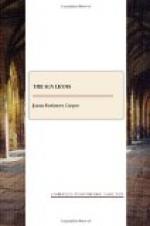Chapter IX.
“Roll on, thou deep and dark blue
ocean—roll!
Ten thousand fleets sweep over thee in
vain;
Man marks the earth with ruin—his
control
Stops with the shore;—upon
the watery plain
The wrecks are all thy deeds, nor doth
remain
A shadow of man’s ravage, save his
own,
When for a moment, like a drop of rain,
He sinks into thy depths with bubbling
groan,
Without a grave, unknell’d, uncoffin’d,
and unknown.”
Byron.
That evening the sun set in clouds, though the eastern horizon was comparatively clear. There was, however, an unnatural outline to objects, by which their dimensions were increased, and in some degree rendered indefinite. We do not know the reason why the wind at east should produce these phenomena, nor do we remember ever to have met with any attempt at a solution; but of the fact, we are certain, by years of observation. In what is called ‘easterly weather,’ objects are seen through the medium of a refraction that is entirely unknown in a clear north-wester; the crests of the seas emit a luminous light that is far more apparent than at other times; and the face of the ocean, at midnight, often wears the aspect of a clouded day. The nerves, too, answer to this power of the eastern winds. We have a barometer within that can tell when the wind is east without looking abroad, and one that never errs. It is true that allusions are often made to these peculiarities, but where are we to look for the explanation? On the coast of America the sea-breeze comes from the rising sun, while on that of Europe it blows from the land; but no difference in these signs of its influence could we ever discover on account of this marked distinction.
Roswell Gardiner found the scene greatly changed when he came on deck next morning. The storm, which had been brewing so long, had come at last, and the wind was blowing a little gale from south-east. The quarter from which the air came had compelled the officer of the watch to haul up on the larboard tack, or with the schooner’s head to the southward and westward; a course that might do for a few days, provided it did not blow too heavily. The other tack would not have cleared the shoals, which stretched away to a considerable distance to the eastward. Hazard had got in his flying-jib, and had taken the bonnets off his foresail and jib, to prevent the craft burying. He had also single-reefed his mainsail and foretopsail. The Sea Lion, of the Vineyard, imitated each movement, and was brought down precisely to the same canvass as her consort, and on the same tack. At that moment the two vessels were not a cable’s length asunder, the Oyster Ponders being slightly to leeward. Their schooner, however, had a trifling advantage in sailing when it blew fresh and the water was rough; which advantage was now making itself apparent, as the two craft struggled ahead through the troubled element.




